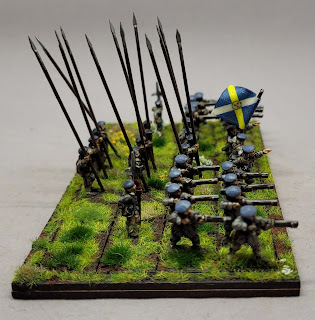Colonel Herbert Morley’s Regiment of Horse
The last of the 'oooo, I've got space in my storage boxes, I'd better fill it' expansion horsey men. I won't be missing death by brown paint for a while.
Colonel Herbert Morley’s Regiment of Horse was a combined Regiment of Horse and Dragoons serving in Waller’s Southern Association, then as garrison of Arundel until they were disbanded in 1653.
Raised in Sussex in April 1643, the Regiment originally consisted of 80 horse and 100 dragoons. By the end of 1643 their strength rose to about 400 men in total.
Combined horse and dragoon regiments appear to be a way of having two small regiments for the price of one: a combined regiment has one colonel (and just one colonel's pay to find). There are a number of examples of these dual regiments recorded, Morley's was not a 'one off'.
There is some confusion as to their first engagements: they were ordered to join Essex's Army at Gloucester, along with the Regiments of Colonels Norton and Harvey, but whether they did so is uncertain. They may, therefore, have fought at the siege of Gloucester, and First Newbury before being ordered to join Waller's Southern Association.
Their joining of the Southern Association was not without incident: the Regiment mutinied over not being paid. When the mutiny was quashed they most likely took part in a number of skirmishes and a standoff at Farnham; a skirmish at Bramber; they then took part in the siege of Arundel, before garrisoning the castle.
In 1644 they ventured off to besiege Basing House, where Morley was wounded taking a musket ball to his shoulder.
In 1645 they were possibly at the siege of Winchester and the storming of Basing House; part of the Regiment would be sent to reinforce the garrison at Abingdon.
1646 saw them take part in the siege of Oxford, and possibly the siege of Wallingford. They then spent the next six years in the garrison of Arundel Castle, where they were ultimately disbanded in October 1653 when the castle's defences were ordered to be sleighted.
The son of the MP Robert Morley of Glynde Place, Sussex. Herbert became a lawyer in 1634, and served as a Justice of the Peace for Sussex from 1641 to 1660. He was the MP for Lewes during the Short and Long Parliaments; and, was a member of the Council of State from 1650 to 1653. He would become MP for Rye during the Protectorate. He refused to negotiate King Charles II of England's return, and would purchase a pardon in 1660 for £1000. He continued to be MP for Rye from 1661 until his death in 1667, although it appears that he did not take his seat in Parliament. He died at home on the 29th September. 1667, aged 51.
Straight from the bag PP figures with a handful of headswaps. These are nearly all two part cavalry, which I much prefer, as I think that they are much better sculpts than the replacement one piece castings: the casualty figure is a one piece casting - it had a hat, which I've swapped out for an open visored three bar pot. Sometimes the resulting figure when you do a headswap looks 'just right': marching drummer with a hat is one of my favourites, this is one of those figures.
If you enjoyed reading this, or any of the other posts, please consider supporting the blog.
Thanks.















Excellent stuff. In each of the photographs, my eye keeps being drawn back to the bugler in blue. Nice.
ReplyDeleteThanks Dex. I certainly think that taking the troop's cornet as inspiration to dress my trumpeters has helped.
Delete